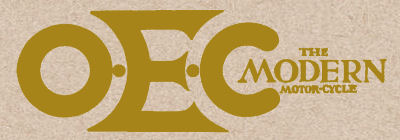


A Brief History of the Marque
Made in Great Britain from 1922 to 1954
Frederick J. Osborn built his first motorcycle using an MMC engine in 1901. After WWI, he produced OEC-Blackburne machines, later shortened to OEC. During the marque's long lifetime models were produced with large capacity V-twin JAP, Blackburne and Matchless engines, and with Villiers two-stroke engines after WWII.
OEC Motorcycles were made in Portsmouth and Gosport. The Hampshire Museum
has several OEC motorcycles, one of which is illustrated here.
OEC Timeline
Sources: Correspondence, VMCC, hants.gov.uk
OEC Duplex Steering
I saw your email request on Sheldon's EMU for a better understanding of the famed OEC Duplex
Steering arrangement. I attach a simple diagram which shows the geometry of the system, so you can have
an idea of how it works. Having ridden many miles on these machines, I can testify to how well it all
works, although the worst feature is its large turning circle and poor manoeuvrability at slow speed and
when wheeling the machine about.
I did also have a frontal collision some years ago with the rear end of a Jeep which stopped suddenly without warning, which demonstrated the excellent impact absorbing properties of the machine!!! The damage looked far worse than it was, as I simply popped the bottom links out and more or less rode home...
I have also attached a picture of my OEC after the accident referred to above... Not a lot of people can have ever seen such a sight!
Kind regards
Martin Shelley
VMCC OEC and Blackburne Marque Specialist
OEC Atlanta Duo
Hi Luke, I note you sent an email some months ago to the Sheldon's EMU webpage asking for information about OEC motorcycles and the
Atlanta Duo in particular. I have been busy of late restoring an old car so missed seeing your email when it was posted, but I have been
the OEC Marque Specialist in the Vintage Motorcycle Club for over twenty years now and can possibly help you.
The Atlanta Duo was an unusual machine as you say, and was introduced in late 1935 for the 1936 season, but only lasted a short while so few examples were sold and as far as I know, none survive. As you can see from the attached copy of the catalogue, it was offered with four engine sizes, and the engine was canted forward to allow a very low seat height and the petrol tank was fitted under the seat above the gearbox to facilitate this. It was arguably the first motorcycle properly designed to carry two people (hence the Duo name), and the contemporary press reports showed it being ridden by two people.
The frame was based on an earlier design called the Whitwood Monocar, which was announced in mid 1934 and was in effect a two wheeled car fitted with the same novel 'Duplex' steering system OEC had pioneered in 1927 and built until the war stopped motorcycle production in late 1939. This is described in the Sheldon webpage about OECs, and there is a picture of my 1938 OEC Duplex Commander after I had an accident which shows the safety benefits of such a system.
I hope this has helped you gain a better understanding of these interesting and unusual machines which I have been a big interest of mine for many years.
Martin Shelley
VMCC OEC and Blackburne Marque Specialist
Member VCC and VSCC
A report from the 1924 Motor Cycle Show reads: "The O.E.C. new model... will undoubtedly be the attraction on this stand. It is a super-sports, having an ingenious duplex frame, consisting of two tubes running direct from the head to the rear fork ends, and two more running to the rear fork ends again. The gear box is suspended independently in the chain stays. A novel feature is the arrangement of the magneto drive, which is by skew gears, which makes for longer life, quieter running, and a more compact power unit. A complete range of models is shown, including the... overhead valve sports model, and the 5-7 h.p. racing machine."
Thu Apr 17 2014
stambourne<at>aol.com
Company History
Osborn Engineering
During WW2 OEC made wheels and legs for Ansons Spitfires etc etc and above all built the Great Panjandrum for D Day an incredible device and a failure!
J S Baker (Osborn's Grandson)
Essex